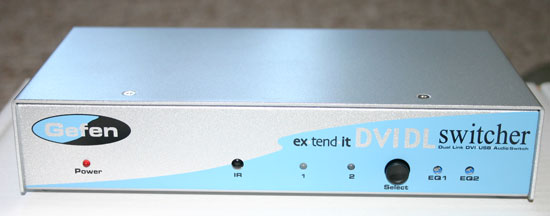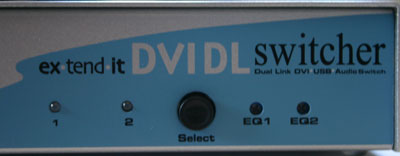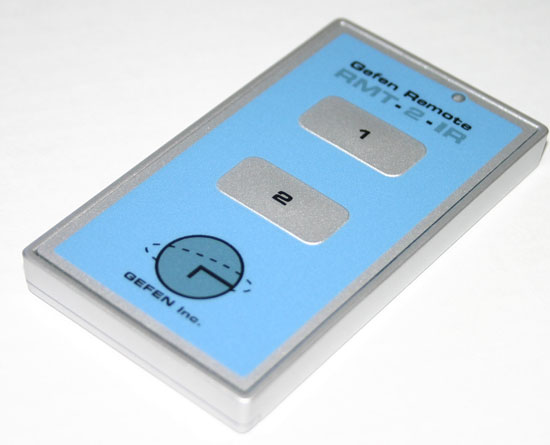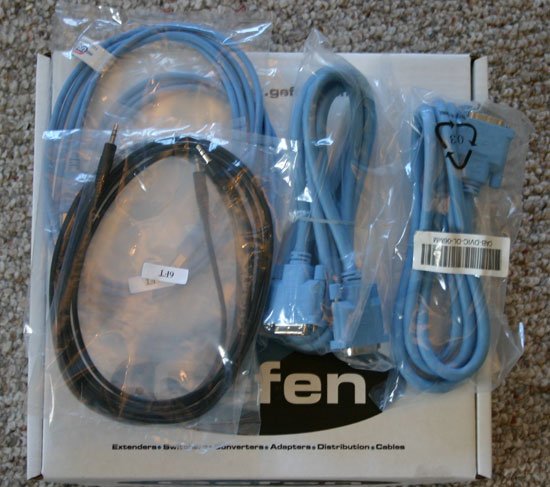Gefen DVI DL: Dual Link DVI + USB KVM
by Anand Lal Shimpi on October 19, 2005 12:05 AM EST- Posted in
- GPUs
Introducing the Gefen DVI DL
Fairly well-known in the home theater community for their HDMI switch boxes, Gefen was the logical choice for finding a dual link DVI KVM. The benefit of a DVI based KVM is that a lot of the issues that plagued old analog VGA KVMs are no longer a problem, thanks to the fact that DVI-I signals are transmitted in the digital domain, meaning that the signal that leaves your computer is exactly what gets displayed on your monitor. With analog VGA based KVMs, you often had image quality degradation at higher resolutions, especially if you happened to have a lower quality KVM. So, in theory, thanks to an all-digital connection, we should have no problems with just about any DVI based KVM switch. Our confidence in the DVI specification aside, we had heard very good things about Gefen, once again from the home theater community - and if anyone has a very critical eye when it comes to image quality, it is the home theater community.
Priced at $399, the Gefen DVI DL is not cheap, but neither is the monitor you'd be hooking this up to, so although we don't agree with the price premium, this product isn't exactly targeted at the low end of the market. So, after you're done buying your $600 video card and $2500 monitor, what's another $400 for the DVI DL?
The Gefen DVI DL is a fairly simple device that acts as an electrical switcher between two computers. The DVI DL will switch between two dual link DVI inputs, analog audio as well as USB 2.0. It is important to note that the DVI DL does not provide USB or DVI "emulation"; in other words, when you switch between systems, it is akin to unplugging the USB and DVI cables from one system and plugging them into the other - that's exactly what the OS "sees" when you switch using the DVI DL. Some units do provide USB emulation, but we'll address this topic later on as we talk about our experiences with the DVI DL.
The only somewhat confusing aspect of the setup deals with USB setup. The two type A ports are labeled USB Out, and this is where you plug in the USB devices that you wish to switch between computers (e.g. keyboard, mouse, etc.). You can even plug in a USB hub to these ports if you'd like (more on that later). The two type B ports are for connecting to your computers: In 1 goes to the first computer and In 2 goes to the second. Obviously, it's very important that DVI 1, In 1 and Audio 1 all go to the first computer, and all of the ports marked "2" connect to the second computer. Otherwise, you'll only be switching some of the components to the right system when you go to hit the select button.
Fairly well-known in the home theater community for their HDMI switch boxes, Gefen was the logical choice for finding a dual link DVI KVM. The benefit of a DVI based KVM is that a lot of the issues that plagued old analog VGA KVMs are no longer a problem, thanks to the fact that DVI-I signals are transmitted in the digital domain, meaning that the signal that leaves your computer is exactly what gets displayed on your monitor. With analog VGA based KVMs, you often had image quality degradation at higher resolutions, especially if you happened to have a lower quality KVM. So, in theory, thanks to an all-digital connection, we should have no problems with just about any DVI based KVM switch. Our confidence in the DVI specification aside, we had heard very good things about Gefen, once again from the home theater community - and if anyone has a very critical eye when it comes to image quality, it is the home theater community.
Priced at $399, the Gefen DVI DL is not cheap, but neither is the monitor you'd be hooking this up to, so although we don't agree with the price premium, this product isn't exactly targeted at the low end of the market. So, after you're done buying your $600 video card and $2500 monitor, what's another $400 for the DVI DL?
The Gefen DVI DL is a fairly simple device that acts as an electrical switcher between two computers. The DVI DL will switch between two dual link DVI inputs, analog audio as well as USB 2.0. It is important to note that the DVI DL does not provide USB or DVI "emulation"; in other words, when you switch between systems, it is akin to unplugging the USB and DVI cables from one system and plugging them into the other - that's exactly what the OS "sees" when you switch using the DVI DL. Some units do provide USB emulation, but we'll address this topic later on as we talk about our experiences with the DVI DL.





The only somewhat confusing aspect of the setup deals with USB setup. The two type A ports are labeled USB Out, and this is where you plug in the USB devices that you wish to switch between computers (e.g. keyboard, mouse, etc.). You can even plug in a USB hub to these ports if you'd like (more on that later). The two type B ports are for connecting to your computers: In 1 goes to the first computer and In 2 goes to the second. Obviously, it's very important that DVI 1, In 1 and Audio 1 all go to the first computer, and all of the ports marked "2" connect to the second computer. Otherwise, you'll only be switching some of the components to the right system when you go to hit the select button.










30 Comments
View All Comments
Questar - Wednesday, October 19, 2005 - link
Apple has it for $2499 on their website.KristopherKubicki - Wednesday, October 19, 2005 - link
Market demand is a weak excuse, but really; it's true. The panel Apple uses is really only used for medical imaging. If someone is going to make it cheap though, it's going to be Dell. They will eventually.Kristopher
sprockkets - Wednesday, October 19, 2005 - link
OK, they are rare, and maybe it wasn't a dual link version, but hell, when you can get a KVM for around what $20 for the VGA version, why bother with $400? Are DVI switchers just going to cost that much since it is digital?Samus - Wednesday, October 19, 2005 - link
If you have two computers and a 30" display, you're a bastard.bersl2 - Wednesday, October 19, 2005 - link
You turn one into a server.
FWIW, I wouldn't bother with this KVM crap.
karioskasra - Wednesday, October 19, 2005 - link
"You have one 30" Cinema Display, and two computers. What do you do?"Well first I'd hit the local bar to try to forget the horrible deeds I had to do to get my hands on that lcd.
JarredWalton - Wednesday, October 19, 2005 - link
What about the potential to simply use shorter cables? Really, it seems like the DVI Detective should just connect inline with the DVI cable and not even require an extra cable. Barring that, a short 5" cable on one side would be able to fix the issue, perhaps?I don't know if you can actually find cables that short, but Gefen ought to be able to do that, right? Since you only need to program the DVI Detective when you change monitors, there's not much point in making them more visible. Of course, requiring people to purchase the DVI Detective in the first place on a $400 product is not really acceptable to most users.
I'd also be interested in hearing how the G5 system fares with a non-ATI card. My own experience is that ATI cards seem to be a bit more picky with EDID information. My (super cheap $25) KVM works fine with NVIDIA cards, but sometimes ATI cards don't know what monitor is attached, defaulting to lowest-common-denominator refresh rates. (I just uncheck the "Use EDID Information" box and manually specify the monitor capabilities in that case, but it's a bit annoying - not sure if anything like that is even an option for Macs, though.)
Anyway, I need a new KVM, preferrably with four ports and USB+DVI support. Thank goodness I don't need dual-link DVI as well!
Beh - Wednesday, October 19, 2005 - link
well, its not all bad, but i do think it needs work. if they integrate the DVI detective functionality and the auto-EQ in their next version it may be worth looking into. for now, i will pass...MAME - Wednesday, October 19, 2005 - link
huge piece of crapumuomgwawwpt - Tuesday, August 25, 2020 - link
http://bitly.com/zoom-viber-skype-psy